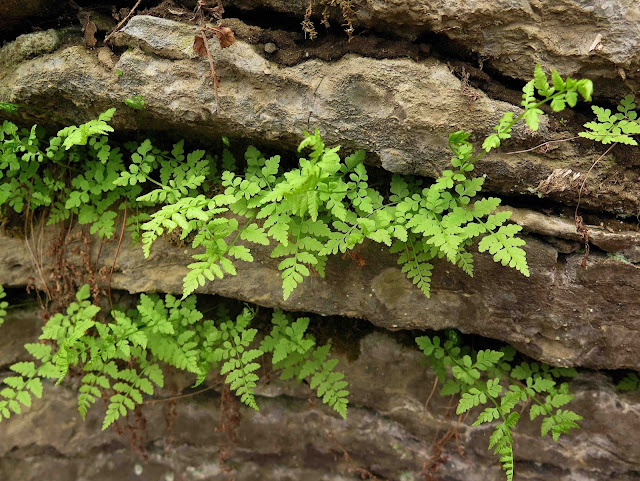A couple of weeks ago, when my friend Sue Pierce and I explored the new Saratoga PLAN property called Glowegee Creek Preserve in Galway, we spent so much time in the northern section, we never made it all the way to the southern trailhead. We were so amazed by the plethora of native wildflowers we'd found at that time, we were eager to see what lay in wait if we entered from the south. So that's where we headed one mostly sunny but cold and blustery day this past week.
Here, Sue makes her way on a well-constructed stone pathway across one of the wetlands that abound in this southern tract.
We had found that the northern section of this preserve consisted of a dry-mesic forest absolutely paved with such lime-loving wildflowers as Blue Cohosh and Squirrel Corn. It was also in that northern section that the trail moved close to the beautiful Glowegee Creek with its picturesque cascading waters. This time, we found a quite different terrain in the southern section, with fewer woodland wildflowers but much more wetland habitat. We had barely entered the preserve from the south when we came upon this lovely pool that was bordered by a limestone ridge.
As we progressed along the Green Trail, we encountered a low-lying swamp that was filled to its edges with the brilliant-yellow flowers and emerald-green leaves of Marsh Marigold (
Caltha palustris).
Here's a closer look at the beautiful flowers of this spectacular native wetland species.
We never encountered the Glowegee Creek along this trail, but we did cross several smaller brooks. This little stream surged around a large rock that was carpeted with a beautiful moss holding its pointed spore capsules aloft on reddish stalks.
The muddy ground near this swampy area held the unfurling fiddleheads of several wetland ferns, including this young Lady Fern (
Athyrium filix-femina). We felt confident identifying this fern, even at this immature stage, by the dark flecks on the stalks. Our mnemonic device, in this case, is "the lady neglected to shave her legs."
We were not so confident, however, in putting a name to these delicate fronds cascading out of the cracks in a limestone ledge. The calcareous rocky substrate led me to suspect it could be Bulblet Fern (
Cystopteris bulbifera), although of course it would not, at this juvenile stage, produce the little bulblets that would clinch that ID. Other newly emerging Bulblet Ferns I have found in other locations had redder petioles, though. So I remain quite unsure. But who needs to put a name to such a thing of beauty, in order to simply enjoy it?
At least I had no trouble identifying these pretty leaves that had crowded into a niche in a limestone wall. The "waterspots" on the compound leaves almost say the name, Virginia Waterleaf (
Hydrophyllum virginianum), out loud.
As I mentioned before, we found many fewer wildflowers in this southern section of the preserve, but there
were a few, including many Red Trilliums (
Trillium erectum) just opening their showy flowers.
Wherever the soil was damp, both species of Toothwort abounded, including this Large Toothwort (
Cardamine maxima) just beginning to open its blooms. This species has three compound leaves protruding from the central stem, a feature that distinguishes it from its close look-alike cousin, the Two-leaved Toothwort (
C. diphylla).
We also saw many Yellow Trout Lilies (
Erythronium americanum), although all of their flowers had closed against the rain and cold of the preceding days. Many Trout Lilies were hiding among the abundant green leaves of Wild Leeks (
Allium tricoccum), a plant that flourishes here in astounding numbers. (I'm going to age myself when I confess this, but this solitary lily hiding among the leeks reminds me of a song I heard on the radio growing up, "I'm a Lonely Little Petunia in an Onion Patch.")
At one point, the trail entered a grove of American Beeches (
Fagus grandifolia), a patch of forest that seemed lit with a silvery light. Here, the forest floor held many tiny Beech seedlings, with gracefully arching baby leaves covered with kitten-soft fur that had just broken free from their sharply pointed bud scales the color of polished copper.
From silvery light and copper buds to golden bark, like that on the otherwise shining bark of this extravagantly shredded Yellow Birch (Betula alleghaniensis). Yes, I consciously use the names of these precious metals to elicit the gleaming quality of this beautiful woods in the spring, before the canopy closes in and takes most of the light for itself. I am sure that the Glowegee Creek Preserve will be beautiful in every season, but I am glad I had a chance to explore it in the spring, both the north and the south, along with my best nature buddy Sue.













3 comments:
oh my, I remember that song about the onion patch, too --- I always used to wonder, "what's an onion patch?" well, at Glowegee, I found out !
You're so lucky to have a good friend who's also a botanist who loves to go on such walks.
Looks like a lovely place to spend some time -- I'm sure you'll be back.
Post a Comment